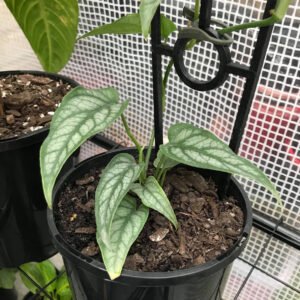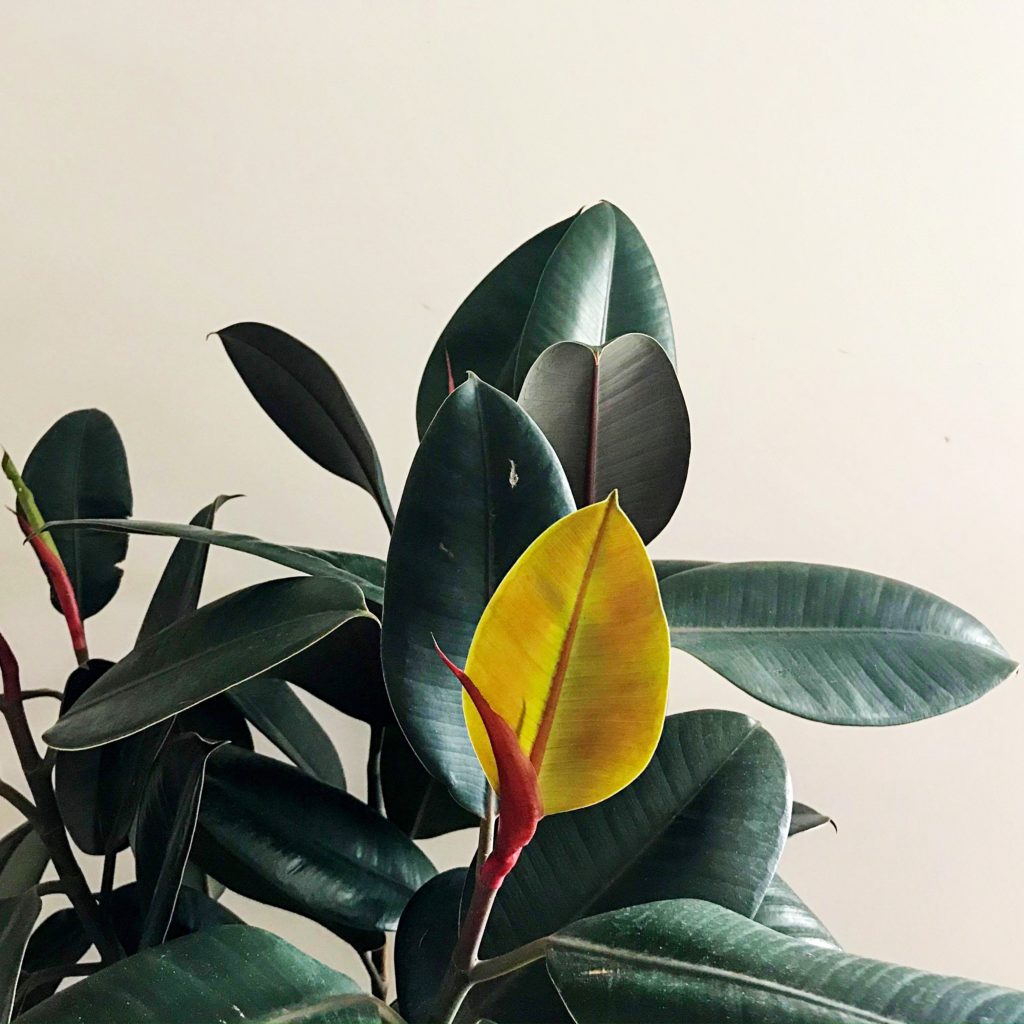Monstera Siltepecana a.k.a Silver Monstera is a rarer plant that is part of the Araceae family, native to Central America and Mexico. In the rainforest, this species of plant is known to start growing at the base of a tree as a juvenile and will climb up the trunk as it matures.
The Monstera Siltepecana has two different appearances in its lifetime. When the plant is a juvenile, the leaves are a bluish grey colour with shades of silver. Once the plant matures, the leaves become a darker green colour and eventually develop fenestrations (holes in the leaves).
Since this type of plant loves to climb, it will grow best when given a pole to climb up. However, this plant will also look amazing in a hanging basket or even in terrariums. Not only does this plant look good, it’s also super easy to propagate!

Monstera Siltepecana Quick Care Overview
| Leaf Size | 2-3 inches long 2 inches wide |
| Light | Bright indirect |
| Temperature | 50˚F-95˚F (10˚C-35˚C) |
| Humidity | Above 60% |
| Cost | $ |
| Care Level | Easy |
| Toxicity | Toxic |
Size
When kept indoors with the correct care, you can expect the leaves of a juvenile Monstera Siltepecana to reach the size of 2-3 inches long and 2 inches wide.
As your plant ages you can expect full size mature leaves to reach a length of 4-5 inches in length. For your plant to develop more mature leaves indoors, you will need to provide it will a sturdy pole and give it time.
Monstera Siltepecana will grow to be around 4 metres in length as a fully developed plant. So make sure to give it plenty of room and poles to climb on.
Monstera Siltepecana Light Requirements
Light is super important when it comes to growing plants indoors as insufficient lighting can cause growth problems. These problems include yellowing leaves, stunted growth, loss of colour and the leaves growing further apart. Browning leaves can be a sign that your plant is not getting enough light or has been over-watered.
Monstera Siltepecana will grow best when positioned in a spot with bright indirect light. Allowing your plant to get some full sun exposure is fine, especially if it’s morning sunlight through an east facing window. However, it’s important that you don’t leave the plant exposed to full sun for too long as the sunlight can burn the foliage. You can add a curtain or blinds to the window to help diffuse the sunlight so the leaves don’t burn.
Temperature
Monstera Siltepecana prefer temperature conditions that range from 50˚F (10˚C) to 95˚F (35˚C). Even though this plant is pretty tolerable to high temperatures, it’s better to try and keep your plant inside this temperature range if you can.
Humidity
Since Monstera Siltepecana are native to rainforests, they prefer a higher humidity (above 60%). This plant will still grow in lower humidity conditions but for best growth, adjusting the humidity will be best. Browning leaves or leaf tips can be a sign that your plant is in a spot where the air is too dry.
Providing humidity for your plants will encourage larger and healthier growth. There are some things you can do that will help increase the humidity in your home.
- Misting plants: Spraying a fine mist over your plants can help to increase the humidity.
- Pebble trays: The water evaporating from the pebbles adds moisture to the air which helps increase humidity.
- Grouping plants together: Having plants grouped together can increase the humidity.
- Humidifier: Humidifiers release water vapour into the air which increases the moisture in the air.
- Greenhouse: Greenhouses are easier at being able to regulate humidity and temperatures.
Monstera Siltepecana Watering Requirements
With this species of plant being native to rainforests, this means it will require a good quantity of water. Monstera Siltepecana will require moderate watering (at least once a week depending on your environment).
Drooping leaves can be a good indicator that your plant needs water but as a rule of thumb, you should check the top 2-3 inches of soil with your finger to feel if the soil is moist. If the top layer of the soil is dry, you should give your Monstera Siltepecana some water.
It’s important that you water thoroughly and allow the water to drain completely. Drooping or curling leaves can also be a sign that your plant needs water.
If you let your Monstera Siltepecana dry out too much between watering, you may notice the lower leaves turning yellow. As a general rule, you can water your plant at least once a week.
Always check the plant before watering as you don’t want the soil to stay too soggy for too long. Allowing the soil to stay too soggy can quickly cause issues like root rot. Yellowing leaves can also be a sign of over-watering.
Ensure your plant is planted in a pot with drainage holes and well draining soil to help avoid over-watering. You should also check that saucers are emptied and plants aren’t sitting in any water.
Fertilizing requirements
You should fertilize your Monstera Siltepecana once a month during the growing period. During the cooler months you can reduce how often you fertilize as the plant isn’t actively growing and using up the nutrients in the soil.
When fertilizing Monstera Siltepecana, you can use a balanced all purpose fertilizer diluted to half strength. Try and avoid any cheap fertilisers that are high in salts as this can damage the roots.
An alternative to using a liquid fertilizer is using a slow release fertilizer. This fertilizer doesn’t need to be applied as often. Apply slow release fertilizer as per instructions on the packaging.
Fertilizing your Monstera Siltepecana will assist in keeping your plant alive as well as promote new and healthy growth.
If you notice your Monstera Siltepecanas leaves are looking discoloured, this can be a sign that your plant is malnourished. The leaves may look pale or yellow in colour and the veins clearly visible.
You should also be cautious of over-fertilizing. Over-fertilizing your plants can burn the roots and foliage. If you think your may have over-fertilised your plant, you can change the soil or rinse the fertilizer out with water. The water colour will change when the fertilizer has been rinsed out.
Soil Requirements
Monstera Siltepecana requires a soil that is loose and well draining. To create this, use a mixture of potting soil, orchid bark, perlite and charcoal. This mix creates drainage and aeration.
Adding perlite and/or orchid bark to any general potting mix will also work. It’s important that you don’t use a soil mix that stays too soggy as this can cause the roots to rot.
Oxygen and airflow is important in potting soil as it allows the roots to breathe. The roots can start rotting if they don’t have access to enough oxygen.
You can also add organic materials like coco coir, mulch chunks or coconut husk to the soil to help retain moisture. You can also add garden compost or worm castings to the soil to add more richness.
Have a look at The Best Potting Soil for Houseplants for more information on potting soil.
Diseases & Pests
The most common pests that you can encounter whilst caring for your Monstera Siltepecana are Spider Mites, Mealybugs, Scale and Aphids. Take a look at Common Houseplant Pests for more information on identifying and treating common pests. Some of the common diseases you may encounter are root-rot and leaf spot.
There are a few things you can do that will assist in preventing any pest infestations. The things you can try are:
- Check new plants for pests or isolate new plants for up to a week.
- Check plants every few days for pests.
- Trim off any dead or dying leaves.
- Wipe down leaves if you notice them getting dusty.
- Keeping your plants healthy. A healthy plant will be able to handle an infestation better than those that aren’t as happy.
- Isolate any plants that have pests.
Following this will assist in keeping pests away as well as catch them early on before any severe infestations are able to start.
Toxicity
Like all the Monstera plants, Monstera Siltepecana are toxic and should be kept away from pets and children. Seek proper medical treatment if this plant is ingested.



